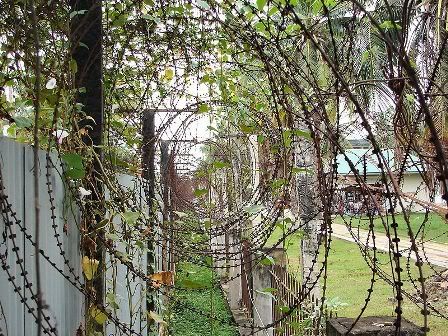
Visiting the High School-turned-Prison-turned-Genocide Museum in Phnom Penh is to see the absolute worst that mankind is capable of. It is also to see just how thin the veneer between civilization and barbarity really is. The scariest part (for me) is how...normal everything looks. The grounds are set within a fairly quiet suburban center of the city, surrounded by the usual combination of shanties and apartments that make up Phnom Penh's housing situation. We sat at a guesthouse across the street before entering, drinking coffee and eating breakfast.
The first sign that not all is what it seems is the thick tangle of barbed wire that stretches over the wall of the entire perimeter. The second is the procession of beggars and homeless that shuffle around the entrance, nearly all of whom are missing limbs. One man's face is almost completely melted away from being doused with acid.
You enter through the front gate, pay a $2 entry fee, and pick up an information pamphlet. There are 5 buildings of the complex, designated as A, B, C, D, and E. The classrooms of the first of these were unaltered from the original design. The large rooms held dozens of prisoners, bound with leg shackles, and arranged like sardines in a can. There was never a square inch between prisoners unless someone had been removed for interrogation. The interrogation rooms were typically set in a medium-sized classroom. The prisoner was set on a raised mattress, and bound with a leg shackle to the headboard. Torture was executed in order to obtain confessions from the individual prisoner, his family, and his closest neighbors. The individual's guilt was never in question. One was considered guilty because he had been arrested...NOT arrested because he was guilty. To question this basic premise was to imply that the Angkar (movement) was fallible. The cots have been left just as they stood, with large dark stains in a circle around them. The blood of countless victims has soaked so deeply into the stone floors that it cannot be washed away. A photo of the last victim of each room has been hung on the wall. When the Vietnamese retook the city, the prison guards rushed to torture the last of the prisoners, and 14 final victims were found in the beds, dead by minutes.
In the D and E buildings, the classrooms had been cordoned off into individual holding cells. Patchwork brick and mortar had been applied, creating cells that were about 3-4 feet wide and 5-6 feet deep. Each was small enough to touch both sides at the same time, and they had been conveniently supplied with a metal can for excrement. Prisoners would be dragged from these cells to the interrogation rooms or the outside grounds to be tortured en masse. Distinct blood stains can be seen here, smudged onto the floor. In one, a tiny, child-sized bloody palm print is visible, as are claw marks on the brick from prisoner's finger nails.
One of the most (of many) disturbing parts of the museum is the large area of photographs of the many prisoners who passed through Tuol Sleng. New-borns, men, women, and children were all treated the same, and their before and after pictures were taken. The Khmer Rouge was similar to the Nazi's in their attention to detail regarding documentation of all that transpired within the compound.
Bryan, Brittany and I walked the grounds for several hours, entering each room of the prison. It was an hour into it before we realized that we had been walking on tip-toe and speaking in whispers the entire time. That would last for an hour after we left.
I'm not sure what kind of person it would take for this, but many of the rooms showed signs of tagging and graffiti from past visitors. People wrote their names and initials, dates they had visited, where they had came from...one gentleman drew a large penis on the wall of a cell where the last prisoners had been tortured to death.
4 comments:
"Cool" seems like the wrong word to check off. It was a nicely documented and well written post. Definitely something everyone should see. I wonder how close we come to touching this kind of darkness at our "black site" prisons. Hopefully not as close as I fear.
Honestly, I don't think we get very close. Not because of any ethical superiority, because I think the lessons from the Khmer Rouge, Nazi Germany and others is that it can happen anywhere, but just because it would be impossible to keep quiet.
People were hearing about the killings, brutality and torture in Cambodia long before it was officially recognized as such. Just like with Guantanomo Bay, the word gets out.
I did find it interesting that water-boarding was one of the KR's preferred methods of torture, however.
Waterboarding is only torture when THEY do it. When we do it, it's just giving them a friendly bath.
Many sites that evidence the most horrific of what mankind is capable of seem disturbingly normal. In Dachau, Germany, you get off the train and walk down a pleasant semi-country road lined with houses to what looks like a park. The gravity doesn't sink in until you're on the premises. It is the very manifestation of the banality of evil--how ordinary people can be compelled to do such extraordinary things. Mercifully, the grace of human compassion eventually allows us to triump our abhorrent capacity for cruelty.
Post a Comment